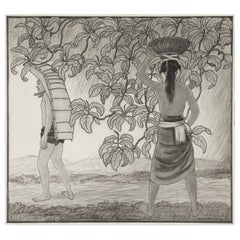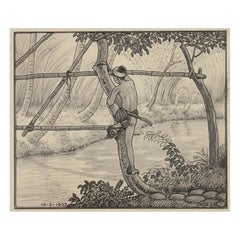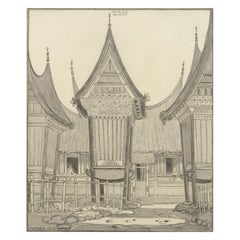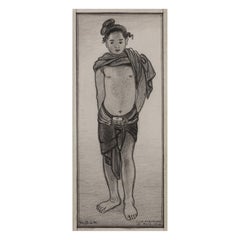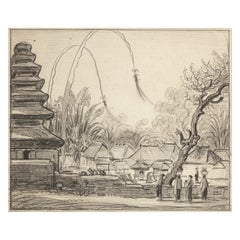Zebregs&Röell
to
5
127
88
85
73
62
45
26
23
20
18
12
12
9
9
6
5
5
5
4
4
2
2
2
1
1
1
1
1
1
1
1
2
2
2
1
1
W.O.J. Nieuwenkamp (1874-1950) Incoming rain, Den Pasar, Bali 1937
Located in Amsterdam, NL
Incoming rain, Den Pasar, Bali 1937
Signed with initials, dated and titled, bottom right
Black chalk and ink on paper, 42 x 46 cm
Literature:
Ernst Braches en J.F. Heijbroek, W.O.J...
Category
Early 20th Century Indonesian Paintings and Screens
Materials
Paper
W.O.J. Nieuwenkamp (1874-1950) 'Four outrigger proa’s on the beach of Kusambe'
Located in Amsterdam, NL
Four outrigger proa’s on the beach of Kusambe, Bali, 1937
Signed with initials, dated and described with location bottom left
Pencil and ink on paper, 29.7 x 35 cm
Category
Early 20th Century Indonesian Paintings and Screens
Materials
Paper
W.O.J. Nieuwenkamp (1874-1950) Wobbly bridge, Tabanan, Bali, 1937
Located in Amsterdam, NL
Wobbly bridge, Tabanan, Bali, 1937
Signed with initials bottom right and dated, bottom left
Pencil and ink on paper, 22 x 26.3 cm
Category
Early 20th Century Indonesian Paintings and Screens
Materials
Paper
W.O.J. Nieuwenkamp (1874-1950) 'Houses in Matoer, Sumatra, 1925'
Located in Amsterdam, NL
Houses in Matoer, Sumatra, 1925
Signed with initials and dated upper centre, W.O.J.N. 30-4-25
Pencil on paper, 34 x 28.8 cm
Literature:
- Ernst Braches and J.F. Heijbroek, W.O.J. N...
Category
Early 20th Century Indonesian Paintings and Screens
Materials
Paper
W.O.J. Nieuwenkamp (1874-1950) 'Young boy at Loemboeng, 1918'
Located in Amsterdam, NL
Signed with initials and dated, bottom right
Black chalk on paper, 25.7 x 10 cm
Literature:
W.O.J. Nieuwenkamp, Zwerftochten door Timor en Onderhoorigheden, Amsterdam 1925, p. 13...
Category
Early 20th Century Indonesian Paintings and Screens
Materials
Paper
W.O.J. Nieuwenkamp (1874-1950) Besakih Temple, Karagasem 1918
Located in Amsterdam, NL
Besakih Temple, Karagasem 1918
Signed with initials and dated lower left, inscribed with location lower right
Charcoal on paper, 26.4 x 32 cm
Category
Early 20th Century Indonesian Paintings and Screens
Materials
Paper
W.O.J. Nieuwenkamp (1874-1950) 'Part of the ring-wall of the Taj Mahal, India'
Located in Amsterdam, NL
Part of the ring-wall of the Taj Mahal, Agra, India, 1914
Signed with initials and dated bottom right
Black chalk on paper, 45.5 x 53 cm
Literature:
Ernst Braches en J.F. Heijbroek...
Category
Early 20th Century Indian Paintings and Screens
Materials
Paper
W.O.J. Nieuwenkamp (1874-1950) 'Stone statue in the temple at Madura, India'
Located in Amsterdam, NL
Stone statue in the temple at Madura, India, 1914
Signed with initials and dated, bottom left
Pencil on paper, 25.4 x 16.7 cm
Literature:
Ernst Braches en J.F. Heijbroek, W.O.J. ...
Category
Early 20th Century Indian Paintings and Screens
Materials
Paper
W.O.J. Nieuwenkamp (1874-1950) Stone statue in the temple at Madura, India, 1914
Located in Amsterdam, NL
Stone statue in the temple at Madura, India, 1914
Signed with initials top right
Pencil on paper, 21.2 x 16.7 cm
Literature:
Ernst Braches en J.F. Heijbroek, W.O.J. Nieuwenkamp,B...
Category
Early 20th Century Indian Paintings and Screens
Materials
Paper
W.O.J. Nieuwenkamp (1874-1950) 'Wadah, Bali 1906’
Located in Amsterdam, NL
'Wadah, Bali 1906’
Signed upper right and with a pencil sketch annotated Boela(?), depot Stedelijk Museum Amsterdam and the artist’s stamp verso
Pen, brush and ink on paper laid do...
Category
Early 20th Century Indonesian Paintings and Screens
Materials
Paper
W.O.J. Nieuwenkamp (1874-1950) 'Meru in Kesiman, Bali 1906’
Located in Amsterdam, NL
'Meru in Kesiman, Bali 1906’
Signed lower centre and annotated lower left
Pen, brush and ink on cardboard, H. 24.4 x W. 17.1 cm
The stately grandeur of the architecture of South Ba...
Category
Early 20th Century Indonesian Paintings and Screens
Materials
Paper
W.O.J. Nieuwenkamp (1874-1950) 'Barong, Ubud en Tabanan Bali 1906’
Located in Amsterdam, NL
'Barong, Ubud en Tabanan Bali 1906’
Signed and described centre right and with artist’s stamp verso Pen, brush and ink on cardboard, H. 16.3 x W. 24.3 cm
While wandering through So...
Category
Early 20th Century Indonesian Paintings and Screens
Materials
Paper
W.O.J. Nieuwenkamp (1874-1950) 'Ingang van den tempel bij Blahbatu, Bali 1907’
Located in Amsterdam, NL
'Ingang van den tempel bij Blahbatu, Bali 1907’
Signed lower centre, titled at the top, and with artist’s stamp at the verso
Pen, brush and ink on cardboard, H. 14.8 x W. 19.4 cm
G...
Category
Early 20th Century Indonesian Paintings and Screens
Materials
Paper
W.O.J. Nieuwenkamp (1874-1950) Temple of Besakih, Karangasem, Bali circa 1907
Located in Amsterdam, NL
Temple of Besakih, Karangasem, Bali circa 1907
Signed lower right
Pencil and watercolour on paper, laid down on thin cardboard, 19.8 x 25.5 cm
Literature:
Ernst Braches and J.F. He...
Category
Early 20th Century Indonesian Paintings and Screens
Materials
Paper
W.O.J. Nieuwenkamp (1874-1950) 'Ida Bagoes Raki, Bali 1906’
Located in Amsterdam, NL
'Ida Bagoes Raki, Bali 1906’
Signed middle right, annotated at the bottom and with artist’s stamp verso
Pen, brush and ink on paper, H. 26.3 x W. 10.8 cm
Ida Bagoes Raki, here 22 y...
Category
Early 20th Century Indonesian Paintings and Screens
Materials
Paper
W.O.J. Nieuwenkamp (1874-1950) Batur Temple and Batur Mountain before eruption
Located in Amsterdam, NL
Batur Temple and Batur Mountain before the eruption, Bali 1904
Signed, dated, and titled lower left and with artist's stamp verso
Pen, brush and ink on cardboard, H. 16.7 x W. 21.8...
Category
Early 20th Century Indonesian Paintings and Screens
Materials
Paper
W.O.J. Nieuwenkamp (1874-1950) Four Balinese, 1910
Located in Amsterdam, NL
Four Balinese, 1910
Signed and dated bottom left
Pencil and ink on paper, 15.6 x 23 cm
Literature:
W.O.J. Nieuwenkamp, Zwerftochten op Bali, Amsterdam, 1910, p. 36
Category
Early 20th Century Indonesian Paintings and Screens
Materials
Paper
W.O.J. Nieuwenkamp (1874-1950) Statue of Vishnu Garuda, Bali, 1904
Located in Amsterdam, NL
Statue of Vishnu Garuda, Bali, 1904
Signed with initials
Pencil and ink on paper, 21.4 x 21.3 cm
Literature:
Bruce W. Carpenter, W.O.J. Nieuwenkamp. First European Artist in Bali, ...
Category
Early 20th Century Indonesian Paintings and Screens
Materials
Paper
W.O.J. Nieuwenkamp (1874-1950) House temple in Singaradja, 1904
Located in Amsterdam, NL
House temple in Singaradja, 1904
Signed with initials upper centre and described with location and date, lower centre (vaguely in pencil 11 oct.).
Pencil, ink and watercolour on pap...
Category
Early 20th Century Indonesian Paintings and Screens
Materials
Paper
W.O.J. Nieuwenkamp (1874-1950) 'A Buginese boat, Semarang 1898’
Located in Amsterdam, NL
'A Buginese boat, Semarang 1898’
Signed, dated, and annotated, upper right Pen, brush and ink on cardboard, H. 11.4 x W. 26.3 cm
Literature:
Venselaar, 2019, p. 69 (ill.)
Category
Antique 19th Century Indonesian Paintings and Screens
Materials
Paper
A superb Japanese export lacquer writing box
Located in Amsterdam, NL
Kyoto, circa 1680
The writing box has bevelled edges and a kabusebuta (overhanging lid), and is completely covered in black lacquer in maki-e and decorated in gold, silver and red h...
Category
Antique 17th Century Japanese Lacquer
Materials
Lacquer
An oval Japanese export lacquer tray
Located in Amsterdam, NL
An oval Japanese export lacquer tray decorated with the alliance of the coats of arms of the Mooyaart and Pauw families
Edo-period, circa 1798
L. 51.5 x B. 37.5 x H.3.2 cm
This tra...
Category
Antique 18th Century Japanese Lacquer
Materials
Lacquer
A Japanese painting depicting two European generals
Located in Amsterdam, NL
Nagasaki, 19th century
H. 98 x W. 41 cm
Provenance:
Private collection, Portugal
Category
Antique 19th Century Japanese Paintings and Screens
Materials
Paper
An exceptional Namban 'escritório' writing-box, with a single drawer
Located in Amsterdam, NL
Kyoto, Late Momoyama to Edo period, circa 1590-1630
Decorated in pearl shell and gold with branches, leaves and flowers inside cartouches on a pearl shell mosaic background.
H. 25 ...
Category
Antique 17th Century Japanese Lacquer
Materials
Gold
A small Japanese export lacquer circular box with a depiction of the Muiderpoort
Located in Amsterdam, NL
Nagasaki, Edo period, 1st half 19th century
Of circular form decorated in gold hiramaki-e on a black-lacquered ground, the lid depicts the Muiderpoort, a city gate of Amsterdam, aft...
Category
Antique 19th Century Japanese Lacquer
Materials
Lacquer
A Japanese rootwood sculpture of Gama Sennin
Located in Amsterdam, NL
Edo period, 18th century
H. 11 x W. 15 cm
Sennin’s are ascetics living as hermits in the mountains, ascribed with magic powers. This Sennin is sitting between rocks on a huge grim-...
Category
Antique 18th Century Japanese Sculptures and Carvings
Materials
Wood
A pair of large Chinese export porcelain dishes with the Valckenier coat-of-arms
Located in Amsterdam, NL
Qianlong period, circa 1735
The dishes are in the so-called encre de chine style and painted on the glaze in rouge de fer and the dominant colours blue, red, pink, black and gold. I...
Category
Antique 18th Century Chinese Ceramics
Materials
Porcelain
A Chinese export 'famille verte' porcelain 'Flanders' armorial dish
Located in Amsterdam, NL
Kangxi period, circa 1700-1710
Diam. 38.4 cm
Three styles of these so-called provincieborden or 'province' dishes were ordered by the Dutch in China between circa 1700 and 1720, ea...
Category
Antique Early 18th Century Chinese Ceramics
Materials
Porcelain
A Chinese export 'famille verte' porcelain 'Groningen' armorial dish
Located in Amsterdam, NL
Kangxi period, circa 1700-1710
Diam. 38.4 cm
Three styles of these so-called provincieborden or 'province' dishes were ordered by the Dutch in China between circa 1700 and 1720, ea...
Category
Antique Early 18th Century Chinese Ceramics
Materials
Porcelain
A Sepik 'panggal' sago spathe or tree bark painting of an ancestral figure
Located in Amsterdam, NL
East-Sepik Province, Keram River, early 20th century
The painting in non-binded pigment on sago spathe, bark of a sago palm, depicts an ancestral figure surrounded by a saw fish...
Category
Early 20th Century Papua New Guinean Tribal Art
Materials
Wood
A Huli wigman's ceremonial headdress
Located in Amsterdam, NL
Papua New Guinea, Central Highlands, Huli people, 1st half 20th century
Crafted from the wearer’s own hair and adorned with colorful bird-of-paradise feathers, flowers, scarab beetl...
Category
20th Century Papua New Guinean Tribal Art
Materials
Shell, Feathers
A pair of monkey skull amulets
Located in Amsterdam, NL
Probably Papua New Guinea, or Borneo, Dayak, late 19th/early 20th century
H. approx. 12 cm (incl. stand, each)
Provenance:
Private collection, Flanders
Category
Antique Late 19th Century Papua New Guinean Tribal Art
Materials
Shell, Beads
A Dutch-colonial Indonesian Sono keeling and paduk miniature chair
Located in Amsterdam, NL
Batavia (Jakarta), early 18th century
H. 79.4 x W. 41.6 x D. 36 cm
H. 31.4 cm (seat height)
This high-back miniature chair, after the Anglo-Dutch Queen Anne style chair with a vase...
Category
Antique Early 18th Century Indonesian Chairs
Materials
Padouk
A drawing of 'Eine Indianische Taube'
Located in Amsterdam, NL
Germany, 18th century
Inscribed Columba Indica dicta Eine Indianische Taube
Watercolour on paper, H. 29.5 x W. 35 cm
Provenance:
Private collection, Germany
Category
Antique 18th Century German Drawings
Materials
Paper
A highly refined Dutch-colonial Sri Lankan inlaid box with silver mounts
Located in Amsterdam, NL
Galle district, 18th century
The box is made of amboyna burr with inlays of ebony, bone and burr wood and has several interior compartments, all made with the utmost attention to de...
Category
Antique 18th Century Sri Lankan Decorative Boxes
Materials
Bone, Ebony, Amboyna
A Dutch colonial ebony box with silver mounts
Located in Amsterdam, NL
Batavia (Jakarta), or Sri Lanka, circa 1680-1720
The document or money box is densely carved with fine scrolling vines and lotus flowers. It has a charming heart- shapes silver lock...
Category
Antique 17th Century Indonesian Antiquities
Materials
Silver
An Indo-Portuguese bone-inlaid ebony and teak writing box with gilt-brass mounts
Located in Amsterdam, NL
India, Goa, 17th century
The box, overall inlaid with a delicate pattern in ebony and bone in teak reserves bordered by brass-studded ebony, is of oblong shape. The corners, lock-pl...
Category
Antique 17th Century Indian Cabinets
Materials
Bone, Ebony, Teak
A Kayapo Amazon Indigenous feather headdress
Located in Amsterdam, NL
Brazil, Pará, circa 1950s-1960s
H. 97 x W. 106 cm
Provenance:
Collection Rinck Hollnberger, Munich
(purchased in the 1980s)
Category
20th Century Brazilian Tribal Art
Materials
String, Feathers
An Amazon Indigenous Kayapo feather headdress
Located in Amsterdam, NL
Brazil, Pará or Mato Grosso, circa 1950’s-1960s
H. 55 x W. 38 cm (incl. stand)
Provenance:
Collection Rinck Hollnberger, Munich
(purchased in the 1980s)
Category
20th Century Brazilian Tribal Art
Materials
String, Feathers
An Amazon Indigenous Kayapo feather headdress
Located in Amsterdam, NL
Brazil, Pará or Mato Grosso, circa 1950’s-1960s
H. 50.8 x W. 33.5 cm (incl. stand)
Provenance:
Collection Rinck Hollnberger, Munich
(purchased in the 1980s)
Category
20th Century Brazilian Tribal Art
Materials
String, Feathers
A colonial tortoiseshell veneered casket with silver mounts
Located in Amsterdam, NL
Possibly Spanish colonial, 17th century
H. 15.2 x W. 25.1 x D. 12 cm
Included is a hand-written letter, reading:
Ik Ondergetekenden verklare bij dezen, dat mijn Wel en Begeerte is...
Category
Antique 17th Century Mexican Antiquities
Materials
Silver
A Dutch East India Company VOC almanack for the year 1785
Located in Amsterdam, NL
"D’Erven Stichter’s Comptoir Almanach, Op ’t Jaar onzes Heeren Jesu Christi, 1785. Voorzien met alle de Jaar-, Paarden-, Beesten-, en Leermarkten, alsmede de Vacantien, het Varen der...
Category
Antique 18th Century Dutch Books
Materials
Leather, Paper
A Dutch West India Company GWC almanack for the year 1760
Located in Amsterdam, NL
"D'Erven Stichter’s Comptoir Almanach, Op ’t Schrikkel-Jaar onzes Heeren Jesu Christi, 1760, voorzien met alle de Jaar-, Paarden-, Beesten-, en Leermarkten Alsmede de Vacantien, het ...
Category
Antique 18th Century Dutch Books
Materials
Leather, Paper
An antique taxidermy Kea (Nestor notabilis)
Located in Amsterdam, NL
England, 19th century
Provenance:
Private collection, Belgium
The kea, indigenous to New Zealand’s Southern Alps, was considered a cunning trickster by the Māori. It is perceived i...
Category
Antique 19th Century English Taxidermy
Materials
Wood, Feathers
An antique taxidermy Duck-billed Platypus (Ornithorhynchus anatinus)
Located in Amsterdam, NL
England, late 19th century
L. approx. 40 cm
Provenance:
Private collection, Belgium
Category
Antique 19th Century English Taxidermy
Materials
Leather
A rare pair of painted armorial Green Sea Turtle shells (Chelonia mydas)
Located in Amsterdam, NL
England, late 19th century
Each large carapace is intricately painted with heraldic emblems. The first shell bears the coat-of-arms of the Tyerman family, while the second depicts t...
Category
Antique Late 19th Century English Taxidermy
Materials
Tortoise Shell
A large classic Louis Vuitton steamer trunk
By Louis Vuitton
Located in Amsterdam, NL
France, circa 1910
The large wooden trunk overall covered with brown LV monogram stamped leather, bound in blackened brass with wooden laths, on four castors, with brass studs all o...
Category
Early 20th Century French Trunks and Luggage
Materials
Brass
A Sri Lankan ebony and cane ‘Easy chair’ or 'planter's chair'
Located in Amsterdam, NL
A Sri Lankan ebony and cane ‘Easy chair’ or 'planter's chair'
Galle, mid-19th century
H. 101 x W. 61 x D. 78.5 cm
H. 38.5 cm (seat height)
Ebony f...
Category
Antique Mid-19th Century Sri Lankan Furniture
Materials
Ebony
A Kuosi society elephant mask
Located in Amsterdam, NL
Bamileke, Cameroon, early 20th century
Among the Bamileke people, only members of the Kuosi society (the elephant society) are permitted to perform elephant masquerades, symbolizing...
Category
Early 20th Century Cameroonian Masks
Materials
Cotton, Beads
An Asmat headdress decorated with cassowary feathers
Located in Amsterdam, NL
Asmat, Papua Province, Indonesia, Late 19th century
Provenance:
- Collection Rinck Hollnberger, Munich (purchased in the 1980s or 1990s)
Category
Antique Late 19th Century Indonesian Tribal Art
Materials
Natural Fiber, Feathers
A silver 'naugari' bracelet
Located in Amsterdam, NL
Rajasthan, India, early 20th century
Called 'Naugari' these bracelets were worn by farmer's wife.
The eight 'gajre' balls attached to the central ring are made from a thick piece of...
Category
Early 20th Century Indian Collectible Jewelry
Materials
Silver
A beautiful black-and-white beaded necklace
Located in Amsterdam, NL
Bonda people, Orissa, early 20th century
The Bonda people are an indigenous tribal group predominantly found in the hilly areas of Malkangiri district in Odisha (Orissa), India. Recognized as one of the oldest and most traditional tribes in the country, they are often regarded as part of the "Adivasi," or the original inhabitants of the region.
Bonda women are renowned for their distinctive traditional attire and adornments. They wear a minimal garment called nala around their waist and embellish themselves with heavy jewelry crafted from beads, metal, and coins. Their hair is typically styled into a bun and covered with a beaded headpiece...
Category
Antique Late 19th Century Indian Tribal Art
Materials
Natural Fiber, Beads
A collection of three embroidered Afghan hats
Located in Amsterdam, NL
Afghanistan, early 20th century
Provenance:
- Collection Rinck Hollnberger, Munich (purchased in the 1980s or 1990s)
Category
Early 20th Century Afghan Antiquities
Materials
Cotton, Silk, Mirror
A pair of silver fibulae from the Atlas Mountains of Morocco
Located in Amsterdam, NL
Atlas Mountains, Morocco, Early 20th century
The usage of the fibula, an ancient piece of jewelry that holds capes and other clothing in place, is unique to North African Berber cos...
Category
Early 20th Century Moroccan Collectible Jewelry
Materials
Silver
An Asmat head ornament made from Cuscus fur
Located in Amsterdam, NL
Asmat, Papua Province, Indonesia, Late 19th century
Made from a long piece of Cuscus fur decorated on the sides with shell beads and strings of natural fiber.
Provenance:
- Collec...
Category
Antique Late 19th Century Indonesian Tribal Art
Materials
Fur, Shell, Natural Fiber
A superb Tibetan Nomad's white coral belt
Located in Amsterdam, NL
Changthang plateau, Tibet, early 19th century
Provenance:
- Collection Rinck Hollnberger, Munich (purchased in the 1980s or 1990s)
Category
Antique Early 19th Century Tibetan Antiquities
Materials
Coral
A Bobo ceremonial top decorated with cowrie shells
Located in Amsterdam, NL
Bobo people, Burkina Faso/Mali, Early 20th century
The top, made in a vest-like form, consists of a base made out of cotton with an outer decorated layer of cowrie shells.
Provenan...
Category
Early 20th Century Burkinabe Tribal Art
Materials
Shell, Cotton
Cassowary feather Bilum bag from Papua
Located in Amsterdam, NL
Papua New Guinea, early 20th century,
A Bilum bag from Papua New Guinea, crafted from bark fiber and adorned with cassowary feathers.
Provenance:
- Collection Rinck Hollnberger, Mu...
Category
Early 20th Century Papua New Guinean Tribal Art
Materials
Natural Fiber, Feathers
A Mbukushu braided headdress
Located in Amsterdam, NL
Mbukushu / Kavango Group, Botswana/Namibia/Angola, Early 20th century
An exquisite and old example of a Mbukushu braided wig headdress, featuring a leather or hide base that has na...
Category
Early 20th Century Namibian Tribal Art
Materials
Leather, Shell, Natural Fiber
A Naga necklace made of red glass paste beads and bronze trumpets
Located in Amsterdam, NL
Ao tribe, Nagaland, Eastern India, Early 20th century
Made from red glass paste beads and bronze trumpets and bells.
The Ao tribe primarily inhabits the Mokokchung district of Naga...
Category
Early 20th Century Indian Tribal Art
Materials
Bronze
